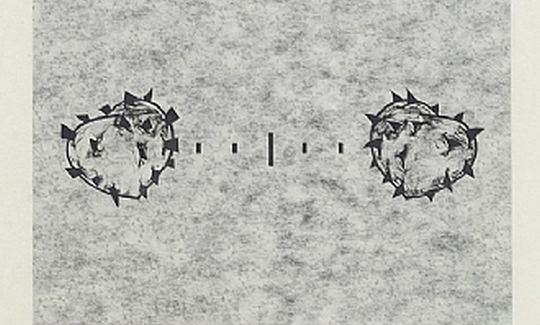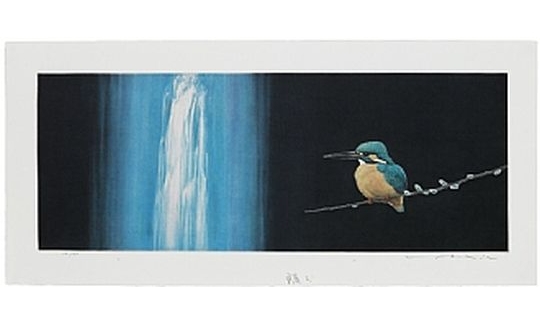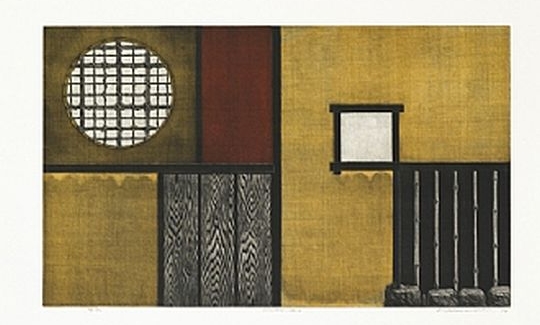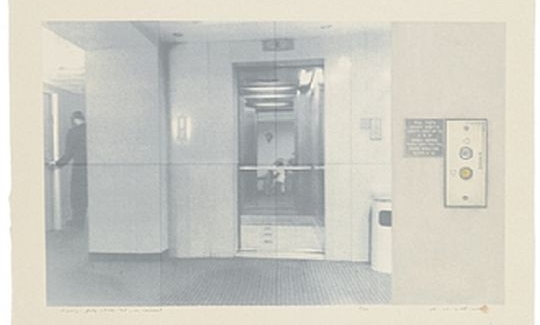This exhibition, celebrating the Jubilee year of the Tikotin Museum of Japanese Art, is the outcome of the initiative of the Yoseido Gallery in Tokyo and the Tikotin Museum. In honour of this festive event we are exhibiting works by 50 contemporary Japanese print artists of the first rank. Most of the works have been created specifically for this exhibition, and most of the artists have decided to donate their works to the Museum when the exhibition closes.
Modern Japanese art is essentially cosmopolitan because of the speed of transmitting information, the artists' travels, and the international exhibitions in which they participate. All artists attempt, in their works, to reflect their natural exposure to the things of the spirit, to current international art trends, and their personal approach to their environment, concretizing events in their own artistic "vocabulary". Obviously, the works in the exhibition are expressions of a broad range of styles and colour.
After Japanese art had encountered that of the West, the graphic medium changed. New methods of expression that reached Japan, such as lithography, silkscreen, etching and engraving were added to the traditional techniques of woodblock printing and stencil, which have a long and glorious history in Japan, but which no longer predominate. Nonetheless, the traditional Japanese art was not discarded in favour of the new, and the art of today is a synthesis of the old and familiar with influences from elsewhere. Like their companions in the West, the Japanese print artists find their way in the current international printmaking stream in regard to both content and medium.
The central motif in the prints of Aki Mana is an arrangement of white lines at different angles and varying proximity, carved into the wooden block. Amid the lines a circular form is sometimes clearly apparent, sometimes obscure.
Animals, a monk wandering in endless snowy wastes, rather humorous figures of Shinto deities registered in monochrome with the addition of a small red patch, rough paper; these are the evidence that this can only be the work of the artist Akiyama Iwao. Akiyama's woodblock prints convey this sense of coarseness, of being "unfinished". He uses Japanese paper in which are embedded scraps of mulberry bark, and the paper is handmade from mulberry fibres. Deliberately departing from elegance or any attempt to beautify or refine his objects, Akiyama depicts them as black, amorphous splashes, with rough outlines and no details. All of this endows his work with a folk-art aspect, naïve and direct.
Aoki Tetsuo creates woodblock prints of people - monochromatic, their heads small in relation to their bodies. Sometimes there is a link between the Chinese ideograms in which he writes the title of a work at the foot of the paper and the arrangement of the figures.
The combinations of colour in the etchings of Arichi Yoshito convey a sense of infinite depth, exemplified in his depictions of clouds. From the first glance, his works draw the viewer inside them.
Baba Tomoko creates etchings of abstract forms that convey a sense of dynamism and energy, filling the space with endless colour.
The abstractions of Curtis F. Midori and Sano Hiraoki combine geometric and figurative forms made rhythmic by colour.
In the monochromatic works of Ebizuka Koichi and Ohya Masaaki the dark surface is covered with lines, over which are scattered different shapes, dark and light - circles, ovals, triangles, squares. The same shapes appear in white on dark, abstract areas that arouse the imagination and offer much space for contemplation.
Endo Susumu's prints combine photography, computer graphics and lithography. He photographs scenes from nature, scans them by computer and modifies them. He then transfers the image to the lithographic plate, from which he prints it on paper. In contemporary art, the artists attach much importance to the spatial relationships in their works. In traditional Japanese art, the empty space plays a central role, and is considered no less important than the depicted object. Endo's works, which he calls "Space and Space", present technological and natural, virtual and figurative spaces. Computerized manipulation thus creates a ‘membrane' separating the digital work, real space, and artificial intelligence - spaces that become increasingly vague and indistinguishable in contemporary art.
A synthesis of local Japanese art and external influences is to be found in contemporary prints that "quote" from traditional Japanese art works but are not identical with those of the past. The artists Hamanishi Katsunori and Tamekane Yoshikatsu have chosen to quote traditional art by affixing gold and silver leaf to the paper, just as it was done on the screens and sliding doors that embellished the finest examples of traditional Japanese mansions. Tsubota Masahiko, Yoshimatsu Junichiro, Sanpei Mitsuo, and Takahashi Yoh also create two-dimensional compositions of areas of colour and texture with interlocking geometric forms.
The works of Amano Junji, Fudezuka Toshihisa, Kobayashi Kiyoko, Kumazaki Akiko, Mita Takeshi, Narumi Shinichi, Okuyama Naoto, Shimada Setsuko, Sugawara Jiro, Tatematsu Osamu and Yamanaka Gen are characterized by simplicity and reduction. However, even though the works convey this sense, they are not really simple at all. Simplicity is necessary in order to deal with the complexity of life, and accordingly it may be the most complicated of all, so that any deliberate attempts to achieve simplicity are doomed to failure.
The subjects of Ikai Tadashi's prints are kingfishers and water, and he succeeds in creating a harmonious balance between their different elements even though his compositions are asymmetrical. Balance is achieved between the shape of an object, its alignment and weight in the picture, and the surrounding space.
Repeated motifs appear in Imamura Yoshio's works - geometric forms, flowers, and others. These motifs are integral to a personal vocabulary that Imamura has developed in his creations.
Ito Rie reverts to a monk-like image with bulging ears and refined physique - is it male or female? The figure is robed in a black garment that creates an abstract shape in the space. The dark shape and its surroundings thus form a system of interwoven positive-negative relationships.
The works of Kasai Masahiro and Wakatsuki Kohei are like haiku - apparently simple representations of a single aspect of nature. They derive from common personal recollections that connect the subject with a specific season, but actually deal with the fourth sense - that of smell, which is necessary for real access to those memories.
Katsuragawa Narumi takes her images from daily life, but endows them with a different meaning. For example, a giant ferris-wheel has become the iris of an eye in the print.
Kinoshita Keisuke, Miyamoto Noriwaki, and Uratani Hiroto combine realism with abstract elements, creating an interesting range of clear and balanced compositions. There is a marked tension between natural and abstract, two-dimensional and three-dimensional.
Kitano Toshimi gives new meaning to familiar, quotidian things such as a leaf or a CD. Kitano's works, and those of Mae Soichiro, Maeno Tomohiko, Ohba Eiji, Ono Koseki, Sato Takako and Shibata Chubun, concentrate on expression of artistic values - colour, form, texture and composition.
Prints by the artist Noda Tetsuya are usually combinations of techniques: woodblock printing, photographs, silkscreen and others. He is known for the works he calls "Diary", images deriving from daily activities or from his travels - a corner of the entrance to a house, a figure reading a newspaper. Apart from documenting his own life, his works are evidence of the pace of prosperity in Japan.
Makino Hiroki, Park Jea Young, Sunaga Takahiro and Suzuki Toshiyasu present corporeal forms that give only the smallest hint of the real subject.
Shinoda Toko combines calligraphy with geometrical abstractions to create a dialogue between traditional and contemporary art.
In Yanagisawa Noriko's prints there are repeated motifs such as broken branches and fossils. These are "concepts" in a language developed by Yanagisawa over the years. They invite the viewer to "read" the works, as if they were open books. The symbols are closely linked to the acts of humankind on the face of the earth. The fossils are "registered" in the natural history books, just as our deeds are registered in Yanagisawa's symbols.
Contemporary Japanese print-making is certainly the liveliest art in our current experience, and gives the impression of being absolutely universal, the preservation of restraint and aesthetic expressing associations with the traditions of the past as seen through the artist's eye. In contemporary art, the use of varying print techniques, an international mode of expression, and the different designs embody the desire of the artists to convey universal themes in their own personal idiom. In common to all of them are absolute control of the various print techniques and the great integrity of their creations. Completeness and perfection predominate, without doubt, in the artistic heritage of the Japanese artists of this generation.
The exhibition is presented under the auspices of the Japan Foundation and the Japanese Embassy in Israel, to whom we extend our grateful thanks.




